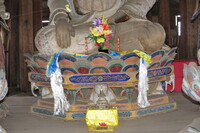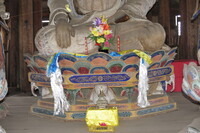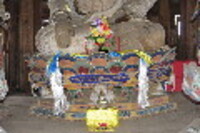| dc.coverage.spatial | Site: Ying County, Shanxi, China | en_US |
| dc.coverage.temporal | 1056 (creation) | en_US |
| dc.creator | unknown (Chinese) | en_US |
| dc.date | 1056 | en_US |
| dc.date.accessioned | 2013-09-25T17:17:25Z | |
| dc.date.available | 2013-09-25T17:17:25Z | |
| dc.date.issued | 1056 | en_US |
| dc.identifier | 235677 | en_US |
| dc.identifier.other | archrefid: 2528 | en_US |
| dc.identifier.uri | http://hdl.handle.net/1721.3/143412 | |
| dc.description | Painted sculpture group, upper level; Shakyamuni Buddha seated on lotus base with offerings; Also called the Mu ta (Timber Pagoda) or Fogong si. One of the extant buildings of the Liao dynasty, a Northern Chinese dynastic period dating from 907 to 1125; it was founded by the proto-Mongolian and nomadic Khitan people. Liao architecture displays Tang influence and an adherence to Buddhism. The pagoda is dedicated to Shakyamuni Buddha. The pagoda stands on a 4 m (13 ft) tall stone platform, has a 10 m (33 ft) tall steeple, and reaches a total height of 67.31 m (220.83 ft) tall; it is the oldest existent fully wooden pagoda still standing in China. The wide, octagonal, five-story (exterior) structure is somewhat squat. The compact bracket system supporting the steeply sloping and projecting eaves is fairly sophisticated, and flying rafters are employed throughout. The structure is unique: its six layers of exterior eaves conceal its interior construction: five interior colonnaded floors and four perimeter galleries, topped by a roof level. Moreover, 56 different bracketing formations have been identified, many of which correspond to illustrations in the Yingzao fashi of 50 years later. Source: Grove Art Online; http://www.oxfordartonline.com/ (accessed 7/31/2012) | en_US |
| dc.format.medium | wood; tile | en_US |
| dc.rights | © Scott Gilchrist, Archivision, Inc. | en_US |
| dc.subject | architecture | en_US |
| dc.subject | deities | en_US |
| dc.subject | Buddhist | en_US |
| dc.subject | Buddhism | en_US |
| dc.subject | Liao | en_US |
| dc.title | Pagoda of Fogong Temple | en_US |
| dc.title.alternative | 佛宫寺释迦塔 | en_US |
| dc.title.alternative | Mu ta (Timber Pagoda) | en_US |
| dc.type | image | en_US |
| dc.rights.access | Licensed for educational and research use by the MIT community only | en_US |
| dc.identifier.vendorcode | 1A2-CH-D-PFT-J10 | en_US |
| vra.culturalContext | Chinese | en_US |
| vra.technique | construction (assembling) | en_US |
| vra.worktype | temple | en_US |
| vra.worktype | pagoda (building) | en_US |
| dc.contributor.display | unknown (Chinese) | en_US |


